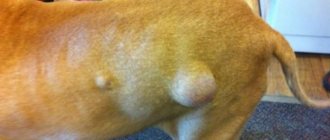Watching your dog bleed, no matter how small, is always a cause for concern and anxiety in pets. If you notice a male dog bleeding from his private area , you are probably worried. This is especially true when there is no sign of a wound and the source of the blood cannot be determined. Therefore, it is important to consult your veterinarian immediately. The veterinarian can make the correct diagnosis and prescribe the necessary treatment...
To give you general information about the various reasons, at HowMeow we will explain the possible reasons why your dog is bleeding from his penis . We'll also look at what you can do in each case, as well as the types of diagnosis and treatment you can expect at a veterinary clinic...
Blood from a dog's penis: a warning sign
Typically, unless your dog has been in an accident or injured, the blood you see from your dog's penis will be a few drops of fresh blood . They may appear at the beginning or end of urination, or you may notice blood flowing without urination.
In any case, if you see your dog bleeding from his penis and still haven't noticed any problems, look for other symptoms of medical conditions, such as:
- More or less frequent urination
- Signs of pain or difficulty urinating.
- languor
- Loss of appetite
Take your dog to the vet as soon as you can. Providing your veterinarian with as much detail as possible about your dog's symptoms will help in diagnosing the problem. We would like to emphasize that only a veterinarian can determine the exact cause of a dog bleeding from his penis and prescribe the necessary treatment...
If a prompt visit to the veterinarian is not possible
You can help your pet at home yourself before going to the clinic. The main thing is not to make things worse.
What to do if your dog is peeing blood?
- You need to provide your pet with peace. Set up a bed for him in a quiet, warm place, surround him with care.
- Drinking regime. Place several bowls of fresh water near your pet. If your pet refuses to drink, you can add a little broth, canned meat sauce, a pinch of vanilla, etc. to the water.
Under no circumstances should you give medications from a human first aid kit without a doctor’s recommendation. First, many drugs cannot be used in animals. Secondly, dosages are completely different for dogs and humans. Thirdly, many drugs have contraindications for use.
To properly provide first aid to your pet while you are unable to take it to the clinic, you can consult with a veterinarian online in the Petstory mobile application. The doctor will collect a detailed medical history, recommend how to help the pet at the moment, and tell you what diagnostics should be carried out. You can download the application from the link.
Why is my dog bleeding from his penis? - Causes
When not associated with trauma or injury , blood from a dog's penis is usually associated with inflammatory diseases or infections caused by one of the following:
- Urethral problems : diseases affecting the urethra and bladder.
- Prostate problems : diseases that affect the reproductive system.
Of course, a dog's urethra is part of the genitourinary system, and disorders in one can often interact or affect the other. In the following sections, we will explain the conditions in each system that can affect a dog and cause penile bleeding...
Instructions for urine collection and first aid
Before going to the veterinarian, fill the test bottle in advance. It is recommended to collect during a morning walk. The genitals must be washed so that excess fluid does not get into the analysis. It is easier to intercept the stream of males with a plastic bottle, but a flat container is suitable for females.
“
Please note that the storage time of the collected liquid is no more than 2 hours. Please ensure that you deliver the collected test within the designated time. Otherwise, the clinical picture will be blurry, and you will have to take tests again.
In most situations, it is recommended to immediately consult a doctor, but if you are poisoned by poison in front of your eyes, you will have to provide first aid. To remove toxins, the dog must be given a laxative or activated charcoal. One sorbent tablet is designed for 10 kg of weight. First, induce vomiting by pouring 50 ml of warm water into your pet’s mouth.
Inducing vomiting is unacceptable only in the following cases:
- pregnancy;
- poisoning with alkalis, acids and petroleum products;
- presence of heart defects;
- loss of consciousness.
If the pet does not come to its senses, lay it on its side and open its mouth. This will help remove the vomit and prevent you from choking until emergency veterinary help arrives.
Urinary tract problems
Canine cystitis usually causes bleeding from the penis, which occurs in the urethra . Associated urinary tract infections or bladder stones can also cause your dog to bleed slightly from his penis. Other possible problems in the urinary system include fungal or viral infections, kidney disease, urethral prolapse or the presence of tumors...
Diagnosis and treatment
To see if blood from a dog's penis is due to a urinary tract disorder, the veterinarian will first take a urine sample . Typically a collection cup is used, just like in humans. However, if this method is not possible or the sample is unreliable, the veterinarian may take a direct sample from the bladder...
The infection is detected by the presence of bacteria and abundant lymphocytes (white blood cells that fight infection). If this is the cause of hematuria - blood in the dog's urine: the veterinarian will prescribe antibiotic treatment. If the symptom is associated with another urinary system disorder, the veterinarian will recommend the appropriate course of treatment...
Physiological processes in which discharge is normal
Estrus (estrus) is a stage of the reproductive cycle. This is a natural process that indicates that the female has reached puberty.
The timing of puberty often depends on the size of the breed. In miniature (small) dogs, the first heat begins earlier, in large dogs - a little later. The first heat occurs at 6-12 months, sometimes at 1.5 years. If the dog does not have it by the age of 2, then some kind of pathology is possible, and a doctor’s consultation is required. On average, the duration of estrus is 20-22 days. The exact cycle will be established in the female only after several heats. Dogs usually come into heat twice a year, and in some animals it happens once a year. If it occurs more often, there may be a risk of hormonal imbalances and a consultation with a specialist is also required.
The dog's reproductive cycle consists of 4 stages:
- Proestrus (pre-gesture) lasts approximately 7-10 days.
At this time, the first signs of estrus in the dog appear: blood flow to the genitals increases, the loop swells, and the first bloody discharge appears. But the dog is not ready for mating, since ovulation has not yet occurred. And her behavior is already changing. During this period, dogs can use panties for estrus.
- Estrus (actually estrus), sexual heat.
During this period, ovulation occurs. The cellular composition of the discharge changes, and in order to determine the dog’s readiness for mating, a smear is performed at the veterinary clinic to determine readiness (i.e., 7-10 days after the first signs of estrus). The discharge itself at this time may also be different for different dog breeds. In some individuals they may be practically absent, in others they become light pink. During the period of estrus, the bitch begins to allow male dogs to approach her: she raises her pelvis, tightens the loop, withdraws her tail and freezes.
- Metaestrus (end of estrus).
The reddish, light pink discharge disappears, the loop decreases in size. The female stops allowing male dogs to approach her. If pregnancy does not occur, the body returns to its normal state over time.
But dogs still have elevated levels of progesterone, and sometimes, regardless of whether fertilization has occurred or not, some bitches develop a false pregnancy, which most often goes away on its own and without consequences. But if suddenly there is a thickening of the mammary glands and a refusal to eat, you should consult a doctor. Drugs are prescribed to stop lactation and eliminate the symptoms of false pregnancy.
- Anestrus (sexual rest) is a period of absence of estrus.
The average duration is 100-150 days.
If estrus is too long (protracted), short, frequent or rare, you should consult a doctor.
Discharge that appears immediately before childbirth (it lasts 3-4 days or a little more) and after labor is also considered normal.
Discharge from a loop in a pregnant dog is a pathology!
That is, any discharge during pregnancy is considered abnormal and can be dangerous. Of course, very slight discharge is present during pregnancy, but it is so small that the owner should not notice it. If there is visible discharge, you need to consult a doctor and undergo an ultrasound. This will help you monitor the course of your pregnancy and find out the approximate number of fetuses.
24-48 hours before birth, sticky and thick discharge of a whitish or grayish color appears. They indicate that the so-called “plug” has come out and the birth process has begun. If you notice that the dog’s discharge before giving birth has a sharp putrid odor and a dark color (green, yellow, brown), if the animal’s body temperature has increased (after all, the temperature normally decreases before giving birth), the female should be immediately taken to the veterinarian and have an ultrasound performed.
After childbirth, the discharge in the first 2-3 days has a brownish color, then it gradually lightens and becomes transparent or with a slight pink tint. The duration of discharge varies from dog to dog. It depends on the size of the dog itself and the number of puppies. Usually, by the end of the maximum 2nd week of the postpartum period, the discharge becomes thinner and stops. That is, the involution of the uterus has occurred - its return to its prenatal size.
Subinvolution of the uterus is also possible - disruption or slowing of the reverse development of the uterus to normal (prenatal) sizes. It is rare and most often occurs in young dogs. Accompanied by prolonged (more than 3-4 weeks) sticky discharge, sometimes mixed with blood. This condition can lead to the development of endometritis (inflammation of the lining of the uterus), and with the addition of a bacterial infection and transition to a more dangerous process - pyometra (purulent inflammation of the uterus). If you experience any similar symptoms, you should consult a doctor.
On the 3-4th day after birth, it is recommended to perform an ultrasound of the uterus, since there is a great danger that the closing cervix may not allow large particles of tissue to pass through (for example, the placenta or placenta, perhaps even an unborn puppy). In this case, additional therapy and dynamic ultrasound are required.
Prostate problems
The prostate is a male reproductive gland that surrounds the urethra. It secretes a fluid that helps with sperm motility. There are three conditions that can lead to an enlarged prostate gland, which is often the cause of a dog bleeding from the penis. These:
- Prostatitis - This is a bacterial infection that affects the prostate and can cause pain, difficulty urinating and blood in the urine, spotting or pus from the dog's penis.
- Prostate neoplasm - This is an abnormal growth in glandular tissue that is often cancerous. For example, prostate cancer in dogs can cause bleeding from the dog's penis, as well as traces of blood in the urine and stool. For more symptoms and treatment options, see our article on prostate cancer in dogs.
- Benign Prostatic Hyperplasia (BPH) This is an enlarged prostate that is the most common cause of penile bleeding associated with the dog's reproductive system. It is related to testosterone production and is common in older male dogs that have not been spayed.
Since BHP is a common cause of bloody discharge in male dogs, we will discuss its diagnosis and treatment in the next section.
A dog has blood in its urine: what should the owner do?
So, as we have determined, blood during urination is almost always an alarming symptom of some disease
. If your dog suddenly pees blood, it is important not to panic, but to observe the animal for several hours. To make a correct diagnosis, the doctor will definitely need not only the results of tests, ultrasound and x-rays, but also the history of observing the dog according to the owner. So, you need to remember the following points if there is blood in your dog’s urine:
- What is the amount of urine
(in case of serious illnesses, the bladder is partially emptied); - How often does the dog pee
(in some diseases, the dog’s urinary tract is blocked as a result of stones or after an injury, which is why the animal cannot pee); - In what position does the dog pee
(if the animal bends too low to the ground and sits down, then this happens with severe pain); - Does the pet show pain when urinating
(whining, breathing heavily, etc.); - Is there blood in the urine
, or maybe there is only discharge on the genitals (for example, when the penis is injured); - How is your pet feeling
(is there a temperature, has he lost his appetite, are there any gastrointestinal disorders, etc.).
Based on the owner’s story, as well as on the basis of test data, the doctor will be able to determine exactly what disorder led to the blood loss. The owner will only have to adhere to the veterinarian’s recommendations, strictly following the instructions of the prescribed medications.
Canine penile bleeding - benign prostatic hyperplasia
As we already mentioned, BPH is hormonal dependent (caused by testosterone), which means that the disorder occurs in unspayed males . All intact male dogs eventually develop this condition, but the most severe symptoms, such as bleeding from the penis, occur in only a few. This may be accompanied by difficulty urinating and defecating. If your dog is suffering from these symptoms, your veterinarian will consider neutering or spaying as a treatment...
Diagnosis of prostate adenoma
Diagnosis of prostate conditions, including benign prostatic hyperplasia, begins when a veterinarian performs a thorough rectal exam . Palpation allows them to determine the size, position and consistency of the prostate gland. If this is enlarged, it will explain why the dog was bleeding from the penis . To determine the exact prostate condition that your dog is suffering from, other diagnostic methods such as x-ray, ultrasound or biopsy can be used...
Treatment of prostate adenoma - castration
Spaying or neutering is the most recommended treatment for BPH that causes clinical symptoms. This is considered the most effective way to remove the stimulus that causes prostate enlargement. This helps reduce the simple size of food and associated problems such as bloody discharge. There are also other benefits to spaying male dogs, with the exception of some specific cases involving behavior problems .
It is also important to consider the risk of surgery on older dogs, although this is possible if previous tests have shown it to be safe. In cases where castration is not recommended, there are medical options such as hormone suppressing medications . Your veterinarian will provide you with more information about treatment options and appropriate recommendations for your dog...
This article is purely informational. HowMeow does not have the authority to prescribe veterinary treatment or diagnosis. We invite you to take your pet to the vet if he has any problems or pain.
Another advantage of castration
There are many benefits of neutering in dogs, with the exception of some special cases of behavior problems. Although we do not intend to describe the entire procedure in detail in this article, we should point out that it is possible to operate on geriatric patients if their preoperative tests give satisfactory results. And, although there is also drug treatment, castration is the only method that completely eliminates the irritant that enlarges the prostate. Thus, soon after the intervention its size decreases and the problem no longer occurs.
Author of the article : Maria Besteiros.
general information
In veterinary medicine, the symptom of a dog urinating blood in the toilet is called hematuria. It is associated with the development of infectious diseases in the animal’s body or dysfunction of the furry friend’s genitourinary system. Experts distinguish three types of hematuria:
- Primary (initial) - urine has a clearly visible red color only at the very beginning of the excretion process.
- There is blood coming out of the urethra even if the dog is not peeing.
- Final type - characteristic changes in the composition of urine are noticeable only at the end of urination.
It is important to understand that the presence of such a symptom in a shaggy friend is a sure sign that the animal is seriously ill. But this is only if the pet has not previously taken medications or foods that can change the natural color of urine (for example, beets). There is no need to assume that the process of coloring the secreted liquid will always be expressed in a bright red color; much more often, urine has a brownish or light pink tint.
An owner who notices signs of strange color changes or foreign matter in the urine should be concerned about why the dog is peeing blood. Only a qualified specialist can determine the exact causes and determine further treatment.











